Analysis of Strategic Plans and Organisational Development Needs
VerifiedAdded on 2021/04/24
|34
|6868
|23
Homework Assignment
AI Summary
This assignment delves into the analysis of strategic plans within the context of organisational development. It explores the importance of analysing strategic plans, identifying key roles in the development process, and assessing an organisation's readiness for change. The assignment includes practical tasks such as analyzing data to address business challenges, defining objectives and strategies for organisational development, and considering effective change management techniques. Furthermore, it involves developing a communication strategy to facilitate the implementation of an organisational development program, providing insights into real-world scenarios and applying theoretical concepts to practical situations. The student has chosen Fonterra as an example organisation to demonstrate the application of OD principles. The assignment covers various aspects of leadership, change management, and strategic planning, aiming to enhance the understanding of organisational development in a dynamic business environment.

Activity A
Instructions to Assessor
Prior to conducting the assessment read this document in its entirety with the individual or group of
learners and seek feedback on the understanding of the assessment requirements and outcomes.
Contextualise the activities, observations/demonstrations and other submitted evidenceto ensure it
reflects the individual learner or group. Check this against the mapping, to ensure it is still valid. This
assessment has been contextualised to better reflect the required learner information and outcome
of assessment.
Ensure that the learner is allocated the appropriate time and resources required for the tasks,
including that the workplace (or simulated environment for learners that are not working) is suitable
for the parameters of any required task, to ensure the learners will have an appropriate opportunity
to satisfactorily demonstrate their required skills and knowledge to result in a Satisfactory (S) result
for the assessment tool and Competent (CO) in the Unit of Competency (UOC) overall.
Advise the learner prior to conducting a practical observation assessment of;
what will occur throughout the assessment process
when the assessment will occur
the level of competency expected
how many times they must be assessed and demonstrate a satisfactory result as per the unit
training pack requirements
When appropriate, confirm arrangements for athird party to observe the learner in the workplace,
with the learner and the third party, including, that the third party understands the requirements
and instructions regarding the Third PartyObservations/Demonstrations. The third party must be
someone in a position to make a valid comment on performance of the learner, e.g. Line Manger
Use the checklists and answer guides to assist you with marking, but never show or share them with
the learner or the third party. Gather supporting documents, where available and appropriate, as
evidence to help you make a judgement of the learner’s competency.
The learner needs to be deemed satisfactory for all of the criteria in the unit to gain competency.
When the assessment is complete, advise the learner of the outcome and record your comments in
the relevant section. You must determine whether they are CO or Not Competent (NC) and provide
appropriate and meaningful feedback.
If you are resulting the learner NC, ensure you outline why you have made this decision, and provide
advice on how the learner can improve skills/knowledge prior to their next attempt.
Where learners are unable to complete the tasks in the methods specified due to situations beyond
your/their control, you will need to make reasonable adjustments, without compromising the
assessment tool(s).
Page 1 of 34
BSBMGT615 Contribute to organisation development
Instructions to Assessor
Prior to conducting the assessment read this document in its entirety with the individual or group of
learners and seek feedback on the understanding of the assessment requirements and outcomes.
Contextualise the activities, observations/demonstrations and other submitted evidenceto ensure it
reflects the individual learner or group. Check this against the mapping, to ensure it is still valid. This
assessment has been contextualised to better reflect the required learner information and outcome
of assessment.
Ensure that the learner is allocated the appropriate time and resources required for the tasks,
including that the workplace (or simulated environment for learners that are not working) is suitable
for the parameters of any required task, to ensure the learners will have an appropriate opportunity
to satisfactorily demonstrate their required skills and knowledge to result in a Satisfactory (S) result
for the assessment tool and Competent (CO) in the Unit of Competency (UOC) overall.
Advise the learner prior to conducting a practical observation assessment of;
what will occur throughout the assessment process
when the assessment will occur
the level of competency expected
how many times they must be assessed and demonstrate a satisfactory result as per the unit
training pack requirements
When appropriate, confirm arrangements for athird party to observe the learner in the workplace,
with the learner and the third party, including, that the third party understands the requirements
and instructions regarding the Third PartyObservations/Demonstrations. The third party must be
someone in a position to make a valid comment on performance of the learner, e.g. Line Manger
Use the checklists and answer guides to assist you with marking, but never show or share them with
the learner or the third party. Gather supporting documents, where available and appropriate, as
evidence to help you make a judgement of the learner’s competency.
The learner needs to be deemed satisfactory for all of the criteria in the unit to gain competency.
When the assessment is complete, advise the learner of the outcome and record your comments in
the relevant section. You must determine whether they are CO or Not Competent (NC) and provide
appropriate and meaningful feedback.
If you are resulting the learner NC, ensure you outline why you have made this decision, and provide
advice on how the learner can improve skills/knowledge prior to their next attempt.
Where learners are unable to complete the tasks in the methods specified due to situations beyond
your/their control, you will need to make reasonable adjustments, without compromising the
assessment tool(s).
Page 1 of 34
BSBMGT615 Contribute to organisation development
Paraphrase This Document
Need a fresh take? Get an instant paraphrase of this document with our AI Paraphraser
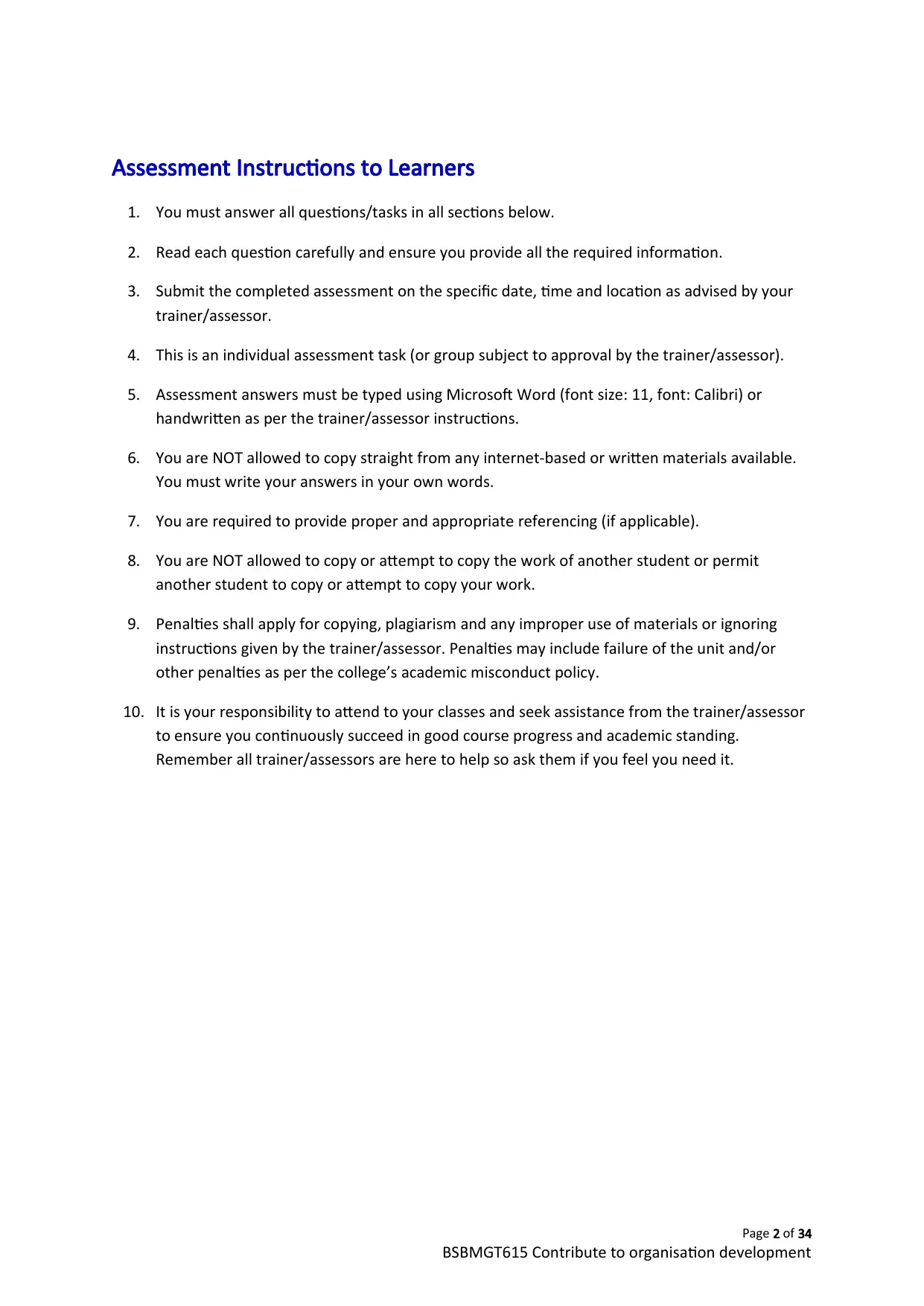
Assessment Instructions to Learners
1. You must answer all questions/tasks in all sections below.
2. Read each question carefully and ensure you provide all the required information.
3. Submit the completed assessment on the specific date, time and location as advised by your
trainer/assessor.
4. This is an individual assessment task (or group subject to approval by the trainer/assessor).
5. Assessment answers must be typed using Microsoft Word (font size: 11, font: Calibri) or
handwritten as per the trainer/assessor instructions.
6. You are NOT allowed to copy straight from any internet-based or written materials available.
You must write your answers in your own words.
7. You are required to provide proper and appropriate referencing (if applicable).
8. You are NOT allowed to copy or attempt to copy the work of another student or permit
another student to copy or attempt to copy your work.
9. Penalties shall apply for copying, plagiarism and any improper use of materials or ignoring
instructions given by the trainer/assessor. Penalties may include failure of the unit and/or
other penalties as per the college’s academic misconduct policy.
10. It is your responsibility to attend to your classes and seek assistance from the trainer/assessor
to ensure you continuously succeed in good course progress and academic standing.
Remember all trainer/assessors are here to help so ask them if you feel you need it.
Page 2 of 34
BSBMGT615 Contribute to organisation development
1. You must answer all questions/tasks in all sections below.
2. Read each question carefully and ensure you provide all the required information.
3. Submit the completed assessment on the specific date, time and location as advised by your
trainer/assessor.
4. This is an individual assessment task (or group subject to approval by the trainer/assessor).
5. Assessment answers must be typed using Microsoft Word (font size: 11, font: Calibri) or
handwritten as per the trainer/assessor instructions.
6. You are NOT allowed to copy straight from any internet-based or written materials available.
You must write your answers in your own words.
7. You are required to provide proper and appropriate referencing (if applicable).
8. You are NOT allowed to copy or attempt to copy the work of another student or permit
another student to copy or attempt to copy your work.
9. Penalties shall apply for copying, plagiarism and any improper use of materials or ignoring
instructions given by the trainer/assessor. Penalties may include failure of the unit and/or
other penalties as per the college’s academic misconduct policy.
10. It is your responsibility to attend to your classes and seek assistance from the trainer/assessor
to ensure you continuously succeed in good course progress and academic standing.
Remember all trainer/assessors are here to help so ask them if you feel you need it.
Page 2 of 34
BSBMGT615 Contribute to organisation development
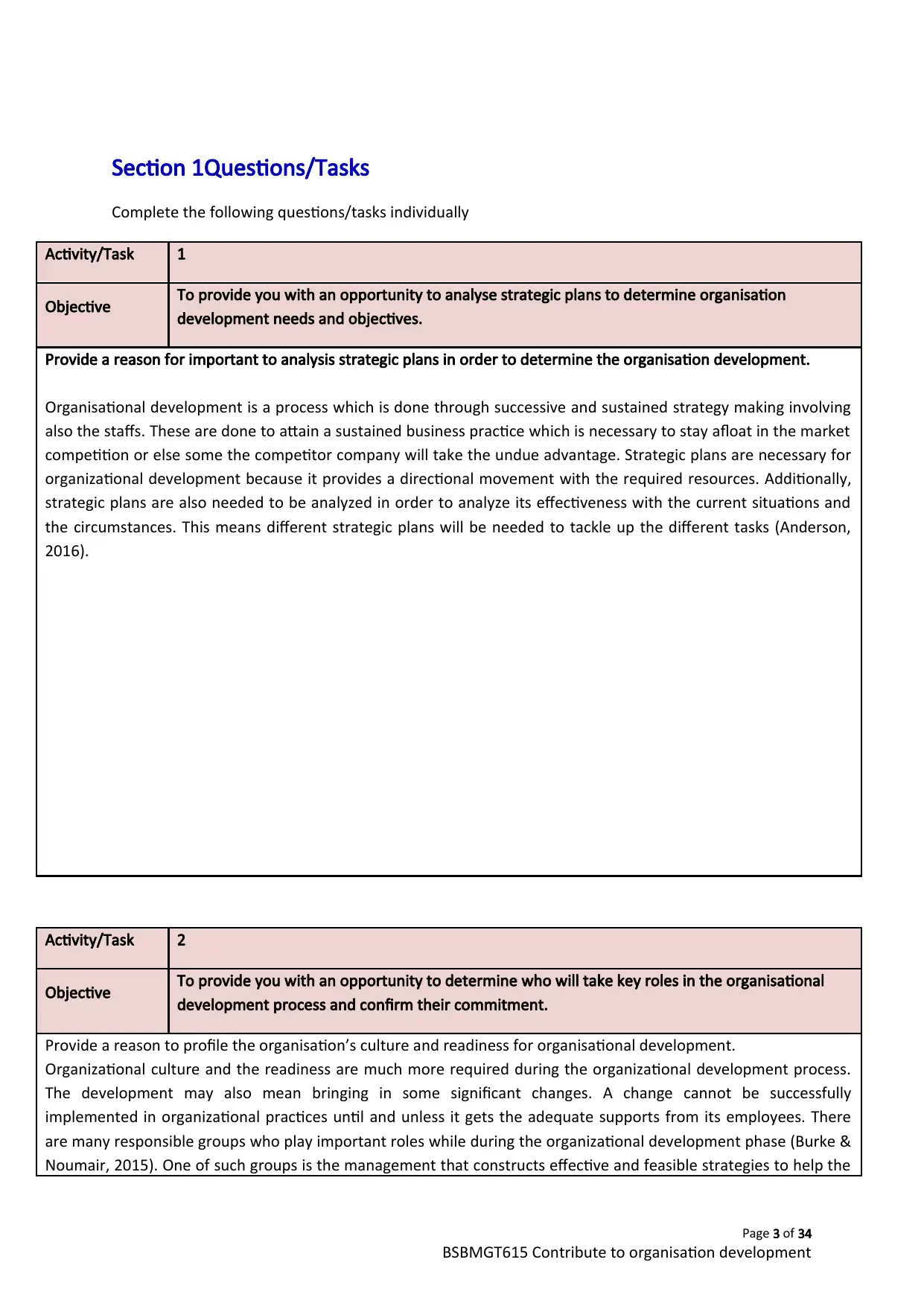
Section 1Questions/Tasks
Complete the following questions/tasks individually
Activity/Task 1
Objective To provide you with an opportunity to analyse strategic plans to determine organisation
development needs and objectives.
Provide a reason for important to analysis strategic plans in order to determine the organisation development.
Organisational development is a process which is done through successive and sustained strategy making involving
also the staffs. These are done to attain a sustained business practice which is necessary to stay afloat in the market
competition or else some the competitor company will take the undue advantage. Strategic plans are necessary for
organizational development because it provides a directional movement with the required resources. Additionally,
strategic plans are also needed to be analyzed in order to analyze its effectiveness with the current situations and
the circumstances. This means different strategic plans will be needed to tackle up the different tasks (Anderson,
2016).
Activity/Task 2
Objective To provide you with an opportunity to determine who will take key roles in the organisational
development process and confirm their commitment.
Provide a reason to profile the organisation’s culture and readiness for organisational development.
Organizational culture and the readiness are much more required during the organizational development process.
The development may also mean bringing in some significant changes. A change cannot be successfully
implemented in organizational practices until and unless it gets the adequate supports from its employees. There
are many responsible groups who play important roles while during the organizational development phase (Burke &
Noumair, 2015). One of such groups is the management that constructs effective and feasible strategies to help the
Page 3 of 34
BSBMGT615 Contribute to organisation development
Complete the following questions/tasks individually
Activity/Task 1
Objective To provide you with an opportunity to analyse strategic plans to determine organisation
development needs and objectives.
Provide a reason for important to analysis strategic plans in order to determine the organisation development.
Organisational development is a process which is done through successive and sustained strategy making involving
also the staffs. These are done to attain a sustained business practice which is necessary to stay afloat in the market
competition or else some the competitor company will take the undue advantage. Strategic plans are necessary for
organizational development because it provides a directional movement with the required resources. Additionally,
strategic plans are also needed to be analyzed in order to analyze its effectiveness with the current situations and
the circumstances. This means different strategic plans will be needed to tackle up the different tasks (Anderson,
2016).
Activity/Task 2
Objective To provide you with an opportunity to determine who will take key roles in the organisational
development process and confirm their commitment.
Provide a reason to profile the organisation’s culture and readiness for organisational development.
Organizational culture and the readiness are much more required during the organizational development process.
The development may also mean bringing in some significant changes. A change cannot be successfully
implemented in organizational practices until and unless it gets the adequate supports from its employees. There
are many responsible groups who play important roles while during the organizational development phase (Burke &
Noumair, 2015). One of such groups is the management that constructs effective and feasible strategies to help the
Page 3 of 34
BSBMGT615 Contribute to organisation development
⊘ This is a preview!⊘
Do you want full access?
Subscribe today to unlock all pages.

Trusted by 1+ million students worldwide

implementation done on the system and bring about the necessary changes. Additionally, employees do have
significant roles in facilitating the organizational development. This is for the reason it is important that the
organization has relevant cultures at the workplace that understand the importance of development process (Burke
& Noumair, 2015).
Activity/Task 3
Objective To provide you with an opportunity to identify international markets operating under free trade
or protectionist arrangements and estimate likely ease of entering and trading successfully.
Provide a reason to determine the commitments of people who have key roles in the organisational development
planning process
There are few key roles in an organizational development process. Those key roles are comprised of but are not
limited to like the human resource, employees, management and the IT professionals. The every single role that has
been mentioned need to maintain their utmost commitment to their assigned responsibilities or else the
development process will get hamper. This is so because every single role is connected to each other and is serving
each other purposes (Smither, Houston & McIntire, 2016). For example, employee’s contribution is also important
for an organizational development process. However, they require training on the change process which is the
responsibility of the human resource management. In case, they have inadequate supports from the HR
management, they might not be able to deliver their best or which is needed the most.
Page 4 of 34
BSBMGT615 Contribute to organisation development
significant roles in facilitating the organizational development. This is for the reason it is important that the
organization has relevant cultures at the workplace that understand the importance of development process (Burke
& Noumair, 2015).
Activity/Task 3
Objective To provide you with an opportunity to identify international markets operating under free trade
or protectionist arrangements and estimate likely ease of entering and trading successfully.
Provide a reason to determine the commitments of people who have key roles in the organisational development
planning process
There are few key roles in an organizational development process. Those key roles are comprised of but are not
limited to like the human resource, employees, management and the IT professionals. The every single role that has
been mentioned need to maintain their utmost commitment to their assigned responsibilities or else the
development process will get hamper. This is so because every single role is connected to each other and is serving
each other purposes (Smither, Houston & McIntire, 2016). For example, employee’s contribution is also important
for an organizational development process. However, they require training on the change process which is the
responsibility of the human resource management. In case, they have inadequate supports from the HR
management, they might not be able to deliver their best or which is needed the most.
Page 4 of 34
BSBMGT615 Contribute to organisation development
Paraphrase This Document
Need a fresh take? Get an instant paraphrase of this document with our AI Paraphraser
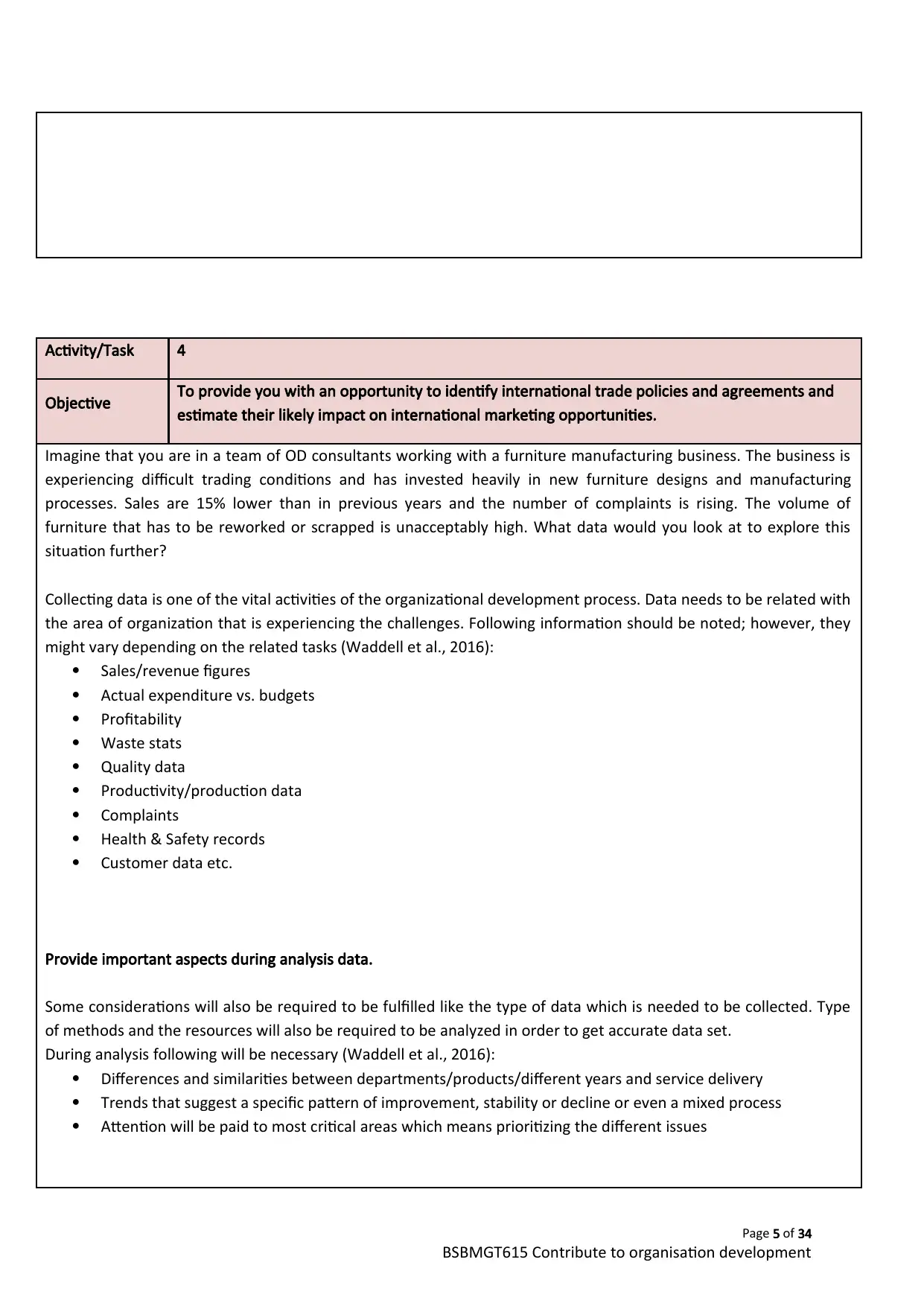
Activity/Task 4
Objective To provide you with an opportunity to identify international trade policies and agreements and
estimate their likely impact on international marketing opportunities.
Imagine that you are in a team of OD consultants working with a furniture manufacturing business. The business is
experiencing difficult trading conditions and has invested heavily in new furniture designs and manufacturing
processes. Sales are 15% lower than in previous years and the number of complaints is rising. The volume of
furniture that has to be reworked or scrapped is unacceptably high. What data would you look at to explore this
situation further?
Collecting data is one of the vital activities of the organizational development process. Data needs to be related with
the area of organization that is experiencing the challenges. Following information should be noted; however, they
might vary depending on the related tasks (Waddell et al., 2016):
Sales/revenue figures
Actual expenditure vs. budgets
Profitability
Waste stats
Quality data
Productivity/production data
Complaints
Health & Safety records
Customer data etc.
Provide important aspects during analysis data.
Some considerations will also be required to be fulfilled like the type of data which is needed to be collected. Type
of methods and the resources will also be required to be analyzed in order to get accurate data set.
During analysis following will be necessary (Waddell et al., 2016):
Differences and similarities between departments/products/different years and service delivery
Trends that suggest a specific pattern of improvement, stability or decline or even a mixed process
Attention will be paid to most critical areas which means prioritizing the different issues
Page 5 of 34
BSBMGT615 Contribute to organisation development
Objective To provide you with an opportunity to identify international trade policies and agreements and
estimate their likely impact on international marketing opportunities.
Imagine that you are in a team of OD consultants working with a furniture manufacturing business. The business is
experiencing difficult trading conditions and has invested heavily in new furniture designs and manufacturing
processes. Sales are 15% lower than in previous years and the number of complaints is rising. The volume of
furniture that has to be reworked or scrapped is unacceptably high. What data would you look at to explore this
situation further?
Collecting data is one of the vital activities of the organizational development process. Data needs to be related with
the area of organization that is experiencing the challenges. Following information should be noted; however, they
might vary depending on the related tasks (Waddell et al., 2016):
Sales/revenue figures
Actual expenditure vs. budgets
Profitability
Waste stats
Quality data
Productivity/production data
Complaints
Health & Safety records
Customer data etc.
Provide important aspects during analysis data.
Some considerations will also be required to be fulfilled like the type of data which is needed to be collected. Type
of methods and the resources will also be required to be analyzed in order to get accurate data set.
During analysis following will be necessary (Waddell et al., 2016):
Differences and similarities between departments/products/different years and service delivery
Trends that suggest a specific pattern of improvement, stability or decline or even a mixed process
Attention will be paid to most critical areas which means prioritizing the different issues
Page 5 of 34
BSBMGT615 Contribute to organisation development
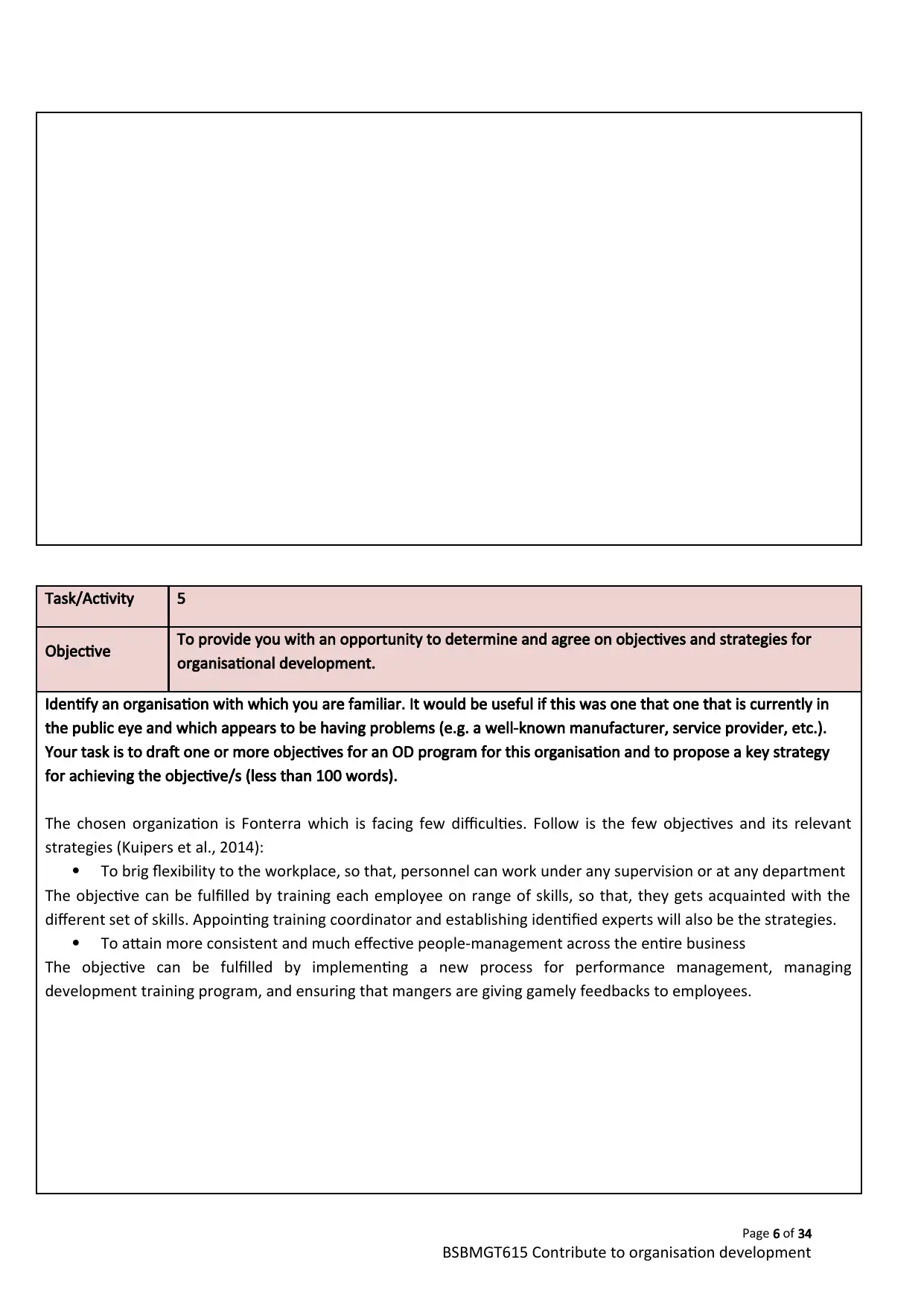
Task/Activity 5
Objective To provide you with an opportunity to determine and agree on objectives and strategies for
organisational development.
Identify an organisation with which you are familiar. It would be useful if this was one that one that is currently in
the public eye and which appears to be having problems (e.g. a well-known manufacturer, service provider, etc.).
Your task is to draft one or more objectives for an OD program for this organisation and to propose a key strategy
for achieving the objective/s (less than 100 words).
The chosen organization is Fonterra which is facing few difficulties. Follow is the few objectives and its relevant
strategies (Kuipers et al., 2014):
To brig flexibility to the workplace, so that, personnel can work under any supervision or at any department
The objective can be fulfilled by training each employee on range of skills, so that, they gets acquainted with the
different set of skills. Appointing training coordinator and establishing identified experts will also be the strategies.
To attain more consistent and much effective people-management across the entire business
The objective can be fulfilled by implementing a new process for performance management, managing
development training program, and ensuring that mangers are giving gamely feedbacks to employees.
Page 6 of 34
BSBMGT615 Contribute to organisation development
Objective To provide you with an opportunity to determine and agree on objectives and strategies for
organisational development.
Identify an organisation with which you are familiar. It would be useful if this was one that one that is currently in
the public eye and which appears to be having problems (e.g. a well-known manufacturer, service provider, etc.).
Your task is to draft one or more objectives for an OD program for this organisation and to propose a key strategy
for achieving the objective/s (less than 100 words).
The chosen organization is Fonterra which is facing few difficulties. Follow is the few objectives and its relevant
strategies (Kuipers et al., 2014):
To brig flexibility to the workplace, so that, personnel can work under any supervision or at any department
The objective can be fulfilled by training each employee on range of skills, so that, they gets acquainted with the
different set of skills. Appointing training coordinator and establishing identified experts will also be the strategies.
To attain more consistent and much effective people-management across the entire business
The objective can be fulfilled by implementing a new process for performance management, managing
development training program, and ensuring that mangers are giving gamely feedbacks to employees.
Page 6 of 34
BSBMGT615 Contribute to organisation development
⊘ This is a preview!⊘
Do you want full access?
Subscribe today to unlock all pages.

Trusted by 1+ million students worldwide
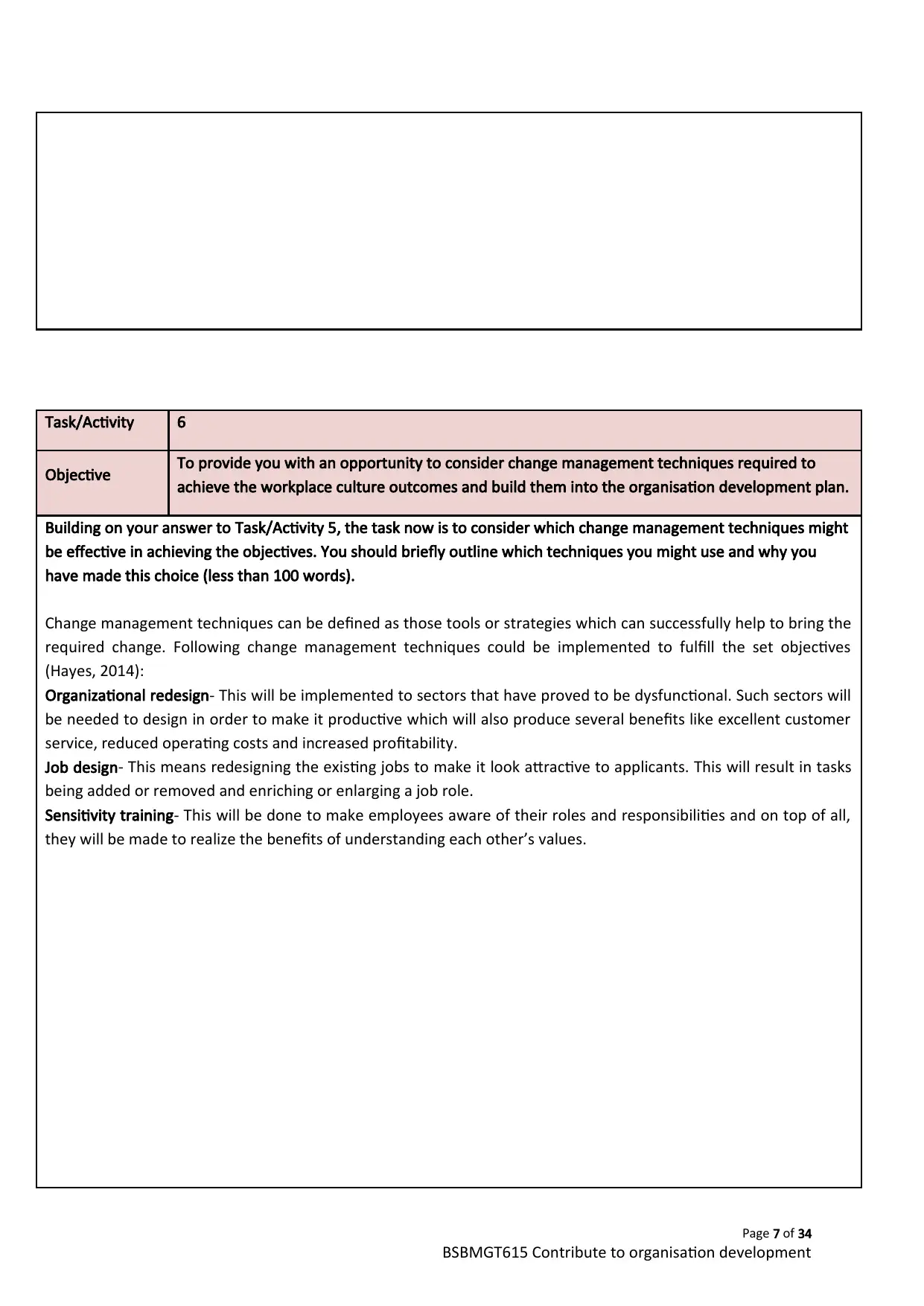
Task/Activity 6
Objective To provide you with an opportunity to consider change management techniques required to
achieve the workplace culture outcomes and build them into the organisation development plan.
Building on your answer to Task/Activity 5, the task now is to consider which change management techniques might
be effective in achieving the objectives. You should briefly outline which techniques you might use and why you
have made this choice (less than 100 words).
Change management techniques can be defined as those tools or strategies which can successfully help to bring the
required change. Following change management techniques could be implemented to fulfill the set objectives
(Hayes, 2014):
Organizational redesign- This will be implemented to sectors that have proved to be dysfunctional. Such sectors will
be needed to design in order to make it productive which will also produce several benefits like excellent customer
service, reduced operating costs and increased profitability.
Job design- This means redesigning the existing jobs to make it look attractive to applicants. This will result in tasks
being added or removed and enriching or enlarging a job role.
Sensitivity training- This will be done to make employees aware of their roles and responsibilities and on top of all,
they will be made to realize the benefits of understanding each other’s values.
Page 7 of 34
BSBMGT615 Contribute to organisation development
Objective To provide you with an opportunity to consider change management techniques required to
achieve the workplace culture outcomes and build them into the organisation development plan.
Building on your answer to Task/Activity 5, the task now is to consider which change management techniques might
be effective in achieving the objectives. You should briefly outline which techniques you might use and why you
have made this choice (less than 100 words).
Change management techniques can be defined as those tools or strategies which can successfully help to bring the
required change. Following change management techniques could be implemented to fulfill the set objectives
(Hayes, 2014):
Organizational redesign- This will be implemented to sectors that have proved to be dysfunctional. Such sectors will
be needed to design in order to make it productive which will also produce several benefits like excellent customer
service, reduced operating costs and increased profitability.
Job design- This means redesigning the existing jobs to make it look attractive to applicants. This will result in tasks
being added or removed and enriching or enlarging a job role.
Sensitivity training- This will be done to make employees aware of their roles and responsibilities and on top of all,
they will be made to realize the benefits of understanding each other’s values.
Page 7 of 34
BSBMGT615 Contribute to organisation development
Paraphrase This Document
Need a fresh take? Get an instant paraphrase of this document with our AI Paraphraser
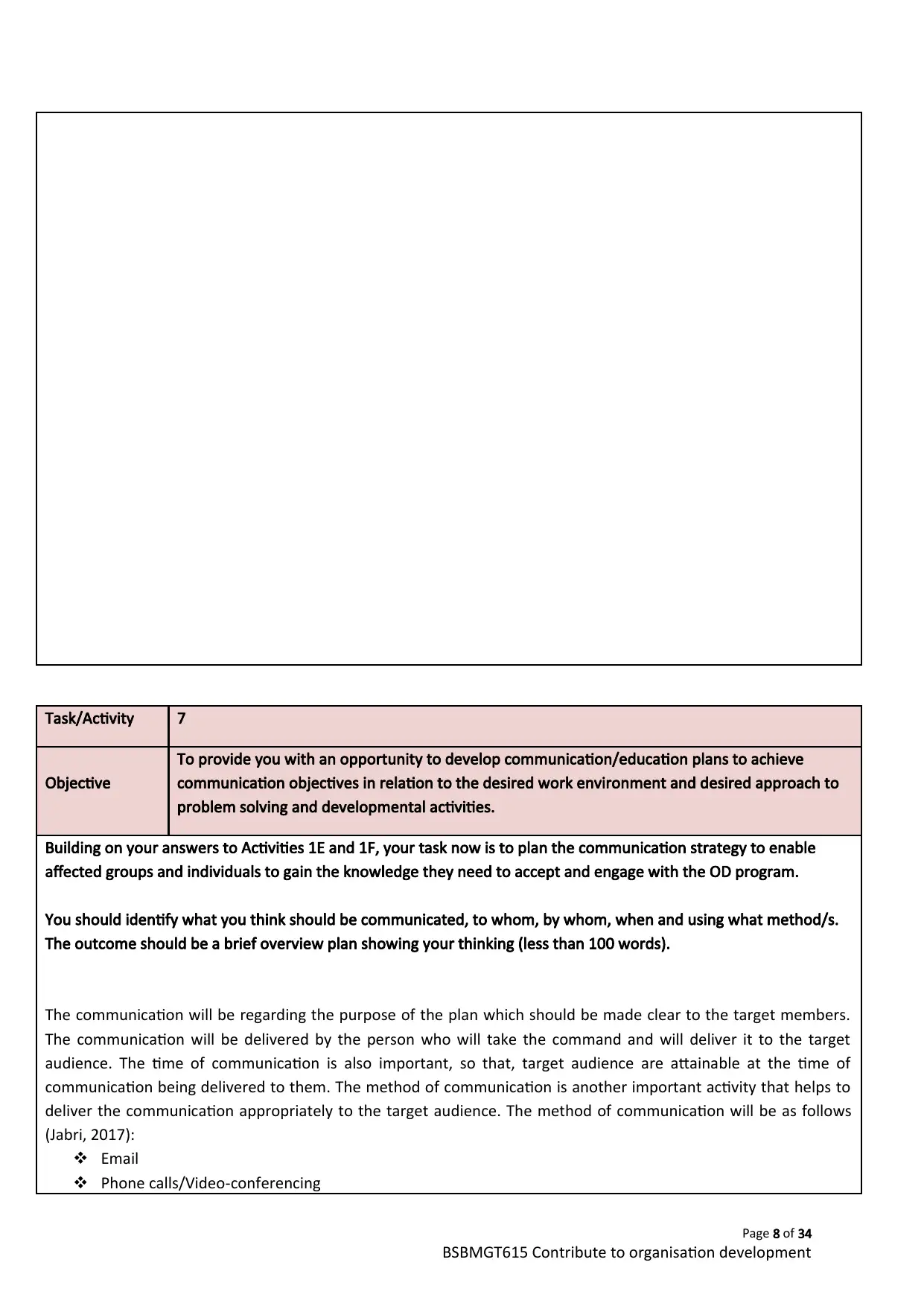
Task/Activity 7
Objective
To provide you with an opportunity to develop communication/education plans to achieve
communication objectives in relation to the desired work environment and desired approach to
problem solving and developmental activities.
Building on your answers to Activities 1E and 1F, your task now is to plan the communication strategy to enable
affected groups and individuals to gain the knowledge they need to accept and engage with the OD program.
You should identify what you think should be communicated, to whom, by whom, when and using what method/s.
The outcome should be a brief overview plan showing your thinking (less than 100 words).
The communication will be regarding the purpose of the plan which should be made clear to the target members.
The communication will be delivered by the person who will take the command and will deliver it to the target
audience. The time of communication is also important, so that, target audience are attainable at the time of
communication being delivered to them. The method of communication is another important activity that helps to
deliver the communication appropriately to the target audience. The method of communication will be as follows
(Jabri, 2017):
Email
Phone calls/Video-conferencing
Page 8 of 34
BSBMGT615 Contribute to organisation development
Objective
To provide you with an opportunity to develop communication/education plans to achieve
communication objectives in relation to the desired work environment and desired approach to
problem solving and developmental activities.
Building on your answers to Activities 1E and 1F, your task now is to plan the communication strategy to enable
affected groups and individuals to gain the knowledge they need to accept and engage with the OD program.
You should identify what you think should be communicated, to whom, by whom, when and using what method/s.
The outcome should be a brief overview plan showing your thinking (less than 100 words).
The communication will be regarding the purpose of the plan which should be made clear to the target members.
The communication will be delivered by the person who will take the command and will deliver it to the target
audience. The time of communication is also important, so that, target audience are attainable at the time of
communication being delivered to them. The method of communication is another important activity that helps to
deliver the communication appropriately to the target audience. The method of communication will be as follows
(Jabri, 2017):
Phone calls/Video-conferencing
Page 8 of 34
BSBMGT615 Contribute to organisation development
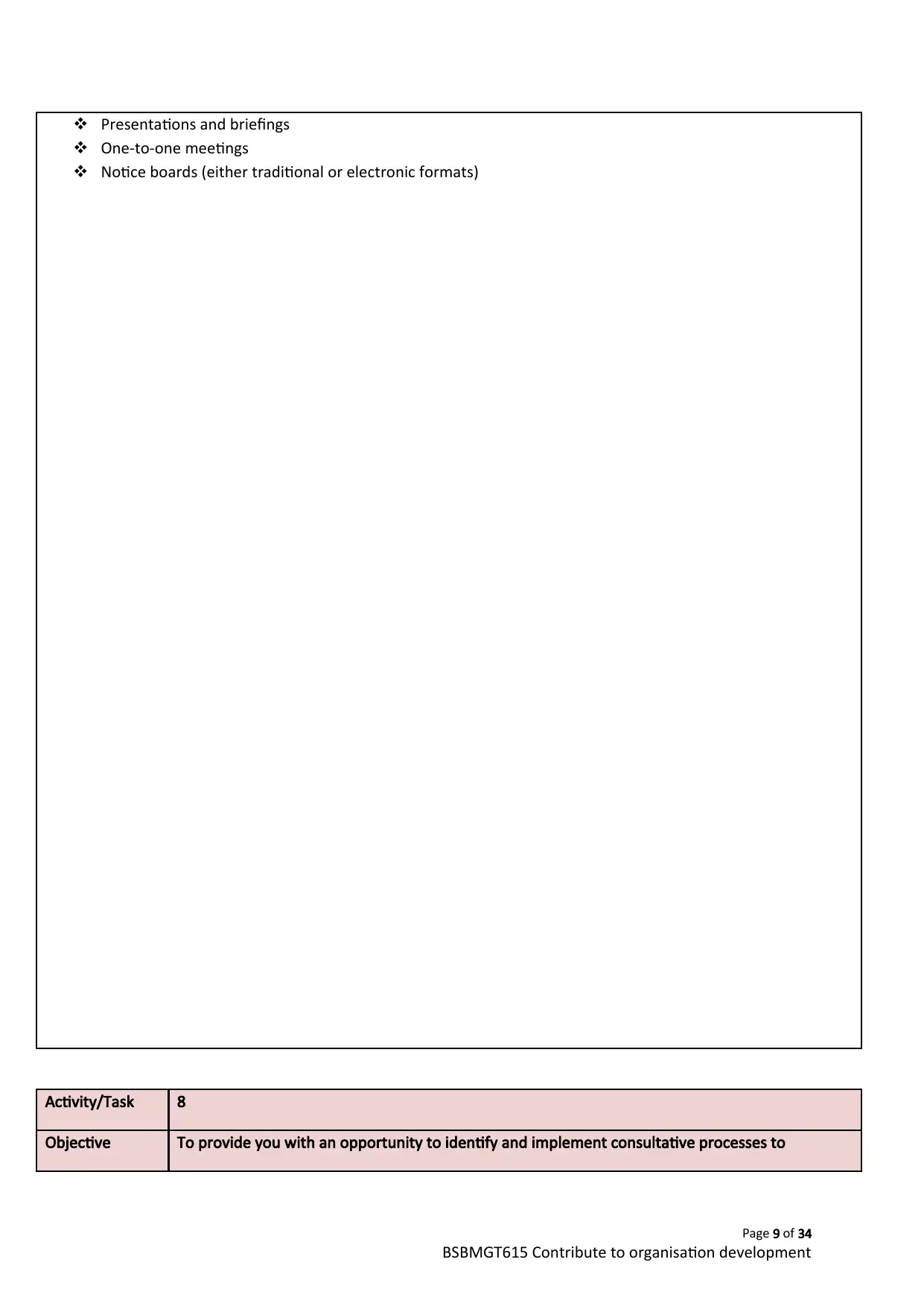
Presentations and briefings
One-to-one meetings
Notice boards (either traditional or electronic formats)
Activity/Task 8
Objective To provide you with an opportunity to identify and implement consultative processes to
Page 9 of 34
BSBMGT615 Contribute to organisation development
One-to-one meetings
Notice boards (either traditional or electronic formats)
Activity/Task 8
Objective To provide you with an opportunity to identify and implement consultative processes to
Page 9 of 34
BSBMGT615 Contribute to organisation development
⊘ This is a preview!⊘
Do you want full access?
Subscribe today to unlock all pages.

Trusted by 1+ million students worldwide
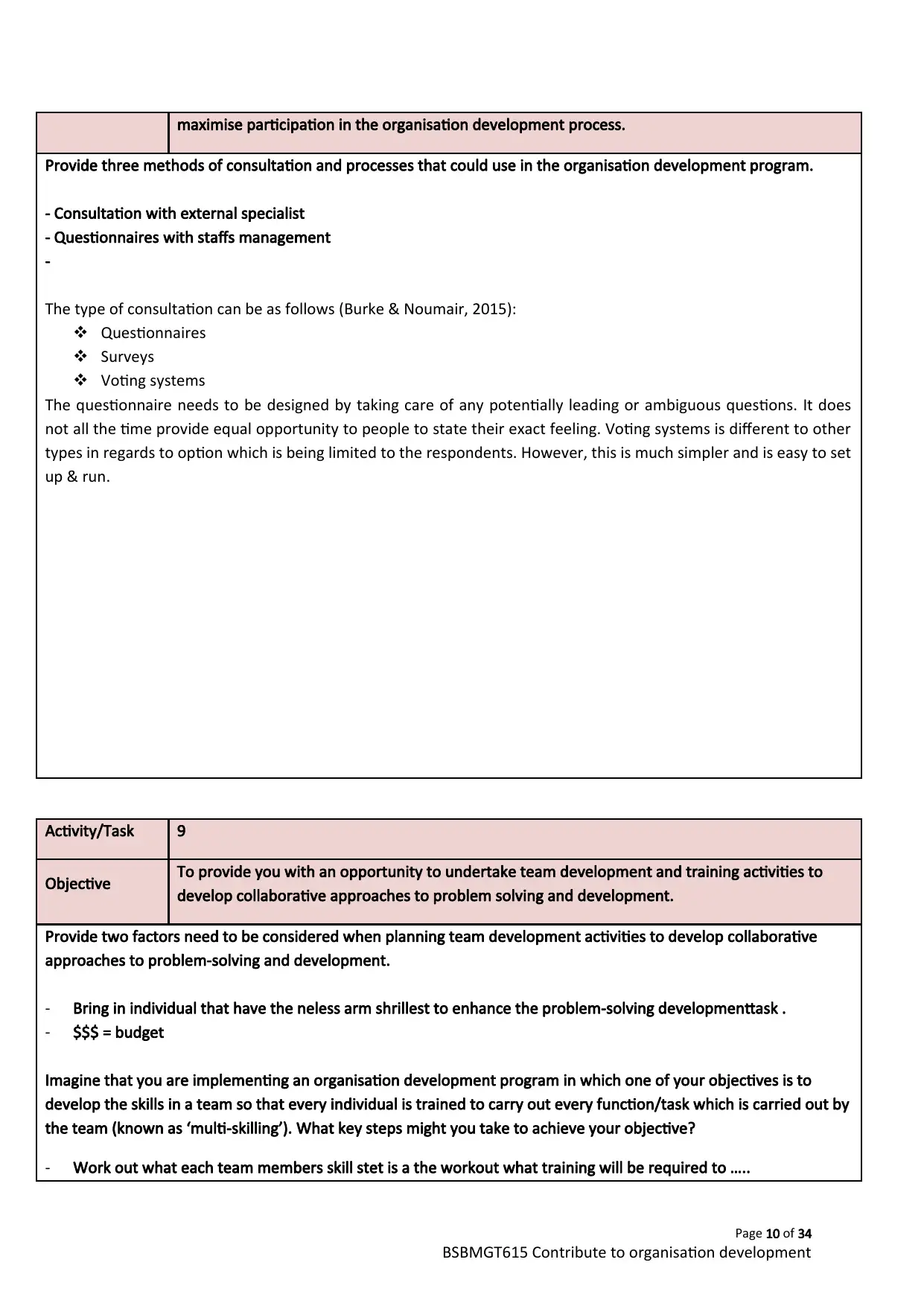
maximise participation in the organisation development process.
Provide three methods of consultation and processes that could use in the organisation development program.
- Consultation with external specialist
- Questionnaires with staffs management
-
The type of consultation can be as follows (Burke & Noumair, 2015):
Questionnaires
Surveys
Voting systems
The questionnaire needs to be designed by taking care of any potentially leading or ambiguous questions. It does
not all the time provide equal opportunity to people to state their exact feeling. Voting systems is different to other
types in regards to option which is being limited to the respondents. However, this is much simpler and is easy to set
up & run.
Activity/Task 9
Objective To provide you with an opportunity to undertake team development and training activities to
develop collaborative approaches to problem solving and development.
Provide two factors need to be considered when planning team development activities to develop collaborative
approaches to problem-solving and development.
- Bring in individual that have the neless arm shrillest to enhance the problem-solving developmenttask .
- $$$ = budget
Imagine that you are implementing an organisation development program in which one of your objectives is to
develop the skills in a team so that every individual is trained to carry out every function/task which is carried out by
the team (known as ‘multi-skilling’). What key steps might you take to achieve your objective?
- Work out what each team members skill stet is a the workout what training will be required to …..
Page 10 of 34
BSBMGT615 Contribute to organisation development
Provide three methods of consultation and processes that could use in the organisation development program.
- Consultation with external specialist
- Questionnaires with staffs management
-
The type of consultation can be as follows (Burke & Noumair, 2015):
Questionnaires
Surveys
Voting systems
The questionnaire needs to be designed by taking care of any potentially leading or ambiguous questions. It does
not all the time provide equal opportunity to people to state their exact feeling. Voting systems is different to other
types in regards to option which is being limited to the respondents. However, this is much simpler and is easy to set
up & run.
Activity/Task 9
Objective To provide you with an opportunity to undertake team development and training activities to
develop collaborative approaches to problem solving and development.
Provide two factors need to be considered when planning team development activities to develop collaborative
approaches to problem-solving and development.
- Bring in individual that have the neless arm shrillest to enhance the problem-solving developmenttask .
- $$$ = budget
Imagine that you are implementing an organisation development program in which one of your objectives is to
develop the skills in a team so that every individual is trained to carry out every function/task which is carried out by
the team (known as ‘multi-skilling’). What key steps might you take to achieve your objective?
- Work out what each team members skill stet is a the workout what training will be required to …..
Page 10 of 34
BSBMGT615 Contribute to organisation development
Paraphrase This Document
Need a fresh take? Get an instant paraphrase of this document with our AI Paraphraser
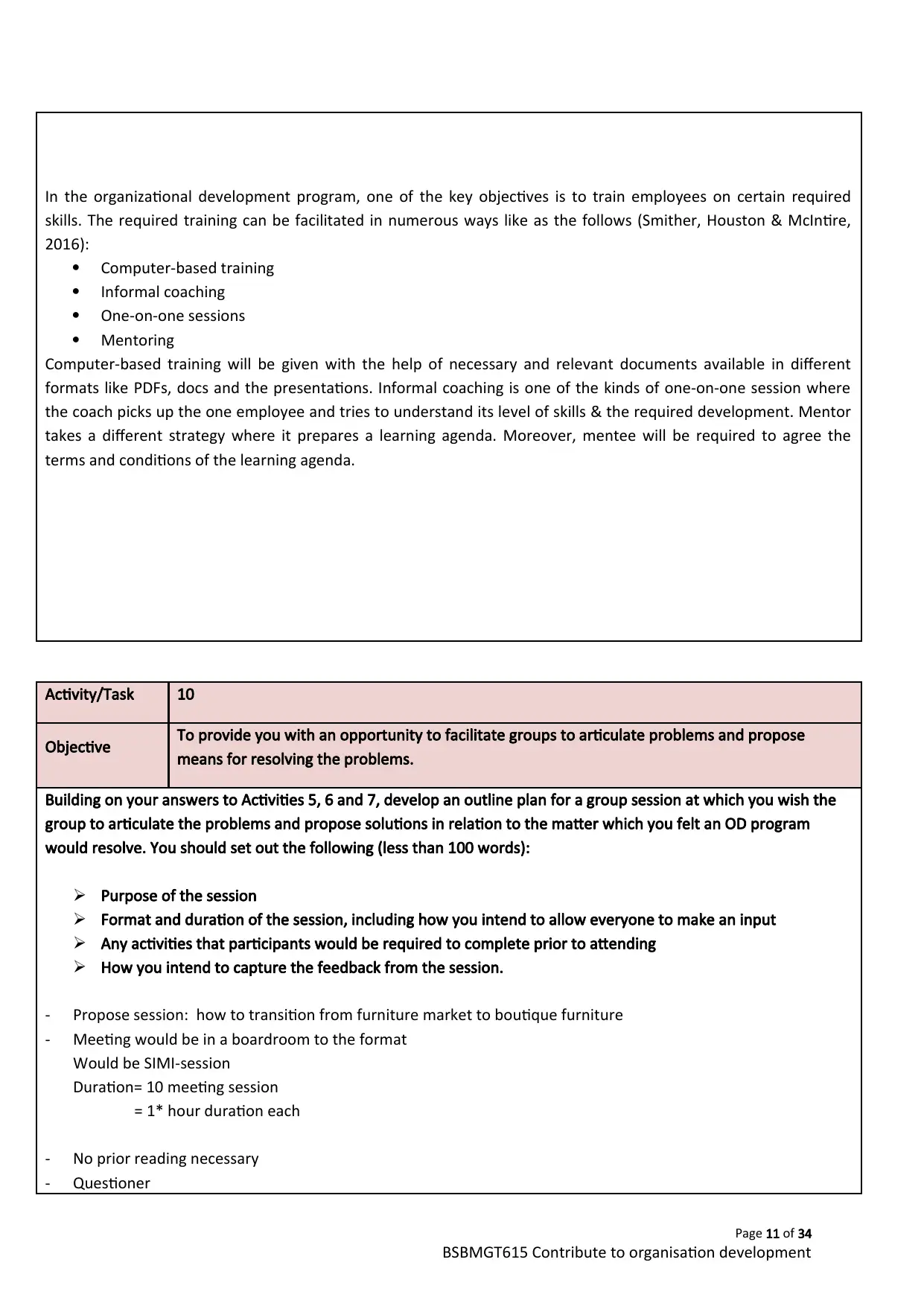
In the organizational development program, one of the key objectives is to train employees on certain required
skills. The required training can be facilitated in numerous ways like as the follows (Smither, Houston & McIntire,
2016):
Computer-based training
Informal coaching
One-on-one sessions
Mentoring
Computer-based training will be given with the help of necessary and relevant documents available in different
formats like PDFs, docs and the presentations. Informal coaching is one of the kinds of one-on-one session where
the coach picks up the one employee and tries to understand its level of skills & the required development. Mentor
takes a different strategy where it prepares a learning agenda. Moreover, mentee will be required to agree the
terms and conditions of the learning agenda.
Activity/Task 10
Objective To provide you with an opportunity to facilitate groups to articulate problems and propose
means for resolving the problems.
Building on your answers to Activities 5, 6 and 7, develop an outline plan for a group session at which you wish the
group to articulate the problems and propose solutions in relation to the matter which you felt an OD program
would resolve. You should set out the following (less than 100 words):
Purpose of the session
Format and duration of the session, including how you intend to allow everyone to make an input
Any activities that participants would be required to complete prior to attending
How you intend to capture the feedback from the session.
- Propose session: how to transition from furniture market to boutique furniture
- Meeting would be in a boardroom to the format
Would be SIMI-session
Duration= 10 meeting session
= 1* hour duration each
- No prior reading necessary
- Questioner
Page 11 of 34
BSBMGT615 Contribute to organisation development
skills. The required training can be facilitated in numerous ways like as the follows (Smither, Houston & McIntire,
2016):
Computer-based training
Informal coaching
One-on-one sessions
Mentoring
Computer-based training will be given with the help of necessary and relevant documents available in different
formats like PDFs, docs and the presentations. Informal coaching is one of the kinds of one-on-one session where
the coach picks up the one employee and tries to understand its level of skills & the required development. Mentor
takes a different strategy where it prepares a learning agenda. Moreover, mentee will be required to agree the
terms and conditions of the learning agenda.
Activity/Task 10
Objective To provide you with an opportunity to facilitate groups to articulate problems and propose
means for resolving the problems.
Building on your answers to Activities 5, 6 and 7, develop an outline plan for a group session at which you wish the
group to articulate the problems and propose solutions in relation to the matter which you felt an OD program
would resolve. You should set out the following (less than 100 words):
Purpose of the session
Format and duration of the session, including how you intend to allow everyone to make an input
Any activities that participants would be required to complete prior to attending
How you intend to capture the feedback from the session.
- Propose session: how to transition from furniture market to boutique furniture
- Meeting would be in a boardroom to the format
Would be SIMI-session
Duration= 10 meeting session
= 1* hour duration each
- No prior reading necessary
- Questioner
Page 11 of 34
BSBMGT615 Contribute to organisation development
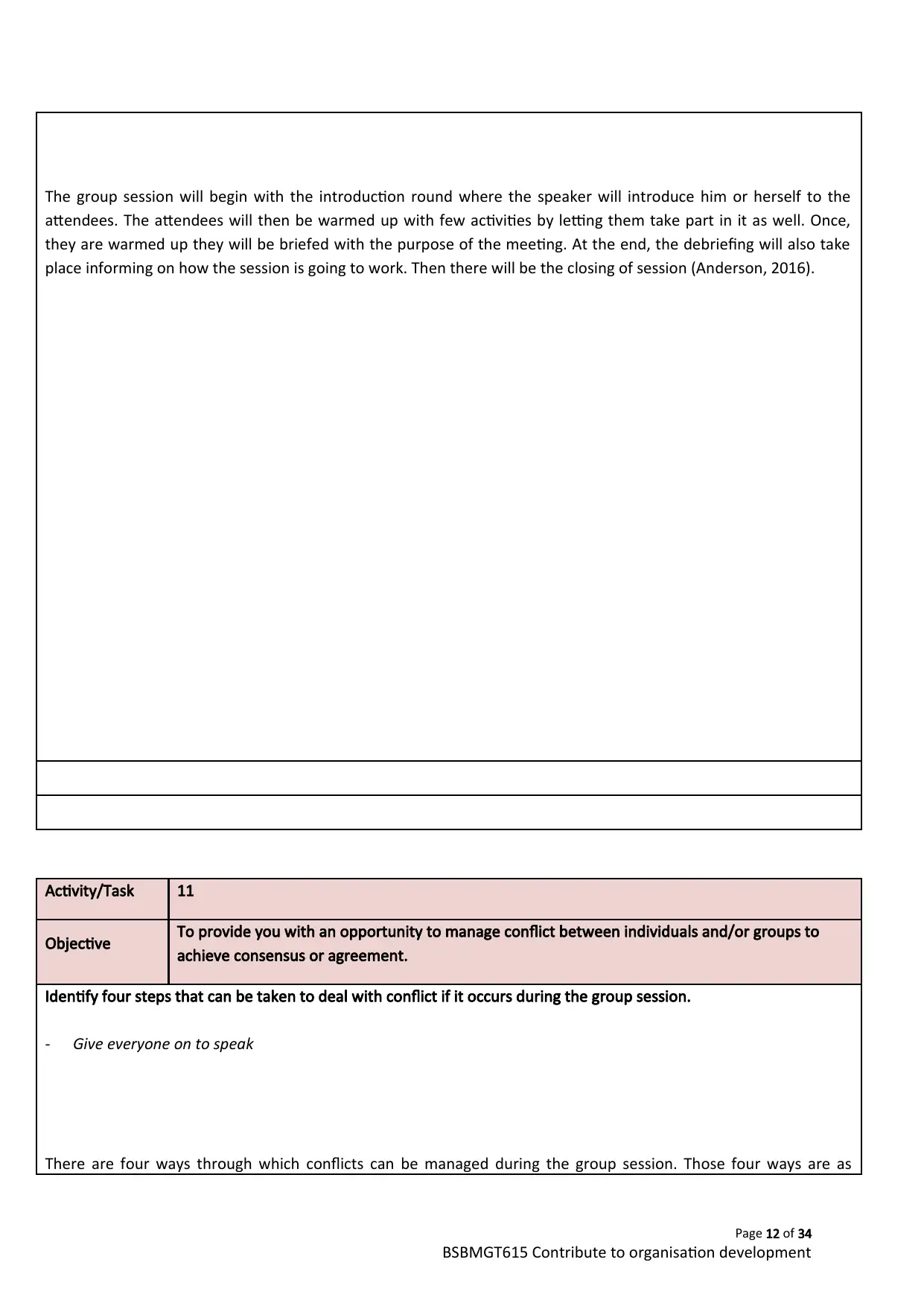
The group session will begin with the introduction round where the speaker will introduce him or herself to the
attendees. The attendees will then be warmed up with few activities by letting them take part in it as well. Once,
they are warmed up they will be briefed with the purpose of the meeting. At the end, the debriefing will also take
place informing on how the session is going to work. Then there will be the closing of session (Anderson, 2016).
Activity/Task 11
Objective To provide you with an opportunity to manage conflict between individuals and/or groups to
achieve consensus or agreement.
Identify four steps that can be taken to deal with conflict if it occurs during the group session.
- Give everyone on to speak
There are four ways through which conflicts can be managed during the group session. Those four ways are as
Page 12 of 34
BSBMGT615 Contribute to organisation development
attendees. The attendees will then be warmed up with few activities by letting them take part in it as well. Once,
they are warmed up they will be briefed with the purpose of the meeting. At the end, the debriefing will also take
place informing on how the session is going to work. Then there will be the closing of session (Anderson, 2016).
Activity/Task 11
Objective To provide you with an opportunity to manage conflict between individuals and/or groups to
achieve consensus or agreement.
Identify four steps that can be taken to deal with conflict if it occurs during the group session.
- Give everyone on to speak
There are four ways through which conflicts can be managed during the group session. Those four ways are as
Page 12 of 34
BSBMGT615 Contribute to organisation development
⊘ This is a preview!⊘
Do you want full access?
Subscribe today to unlock all pages.

Trusted by 1+ million students worldwide
1 out of 34
Related Documents
Your All-in-One AI-Powered Toolkit for Academic Success.
+13062052269
info@desklib.com
Available 24*7 on WhatsApp / Email
![[object Object]](/_next/static/media/star-bottom.7253800d.svg)
Unlock your academic potential
Copyright © 2020–2025 A2Z Services. All Rights Reserved. Developed and managed by ZUCOL.




